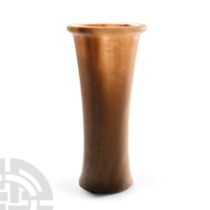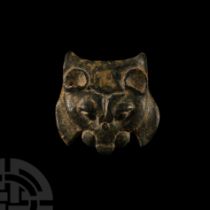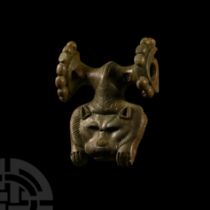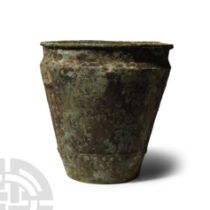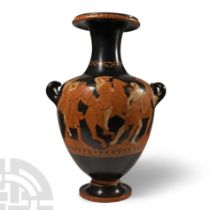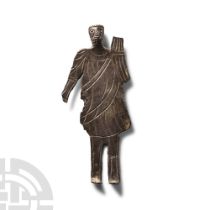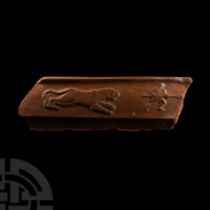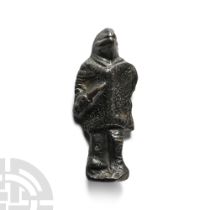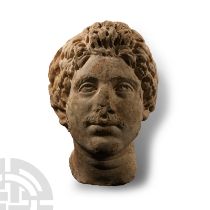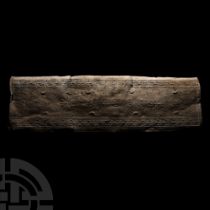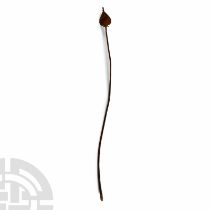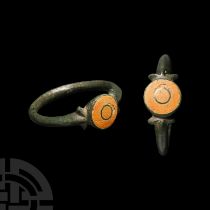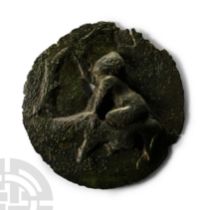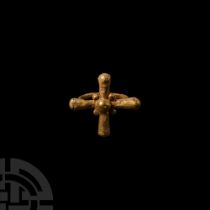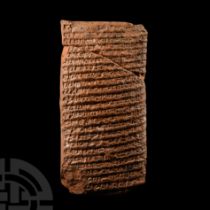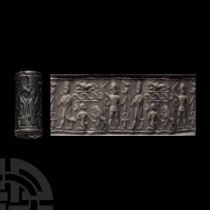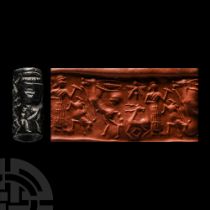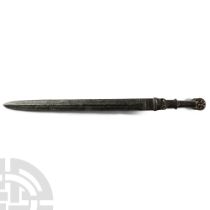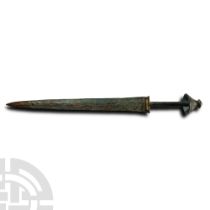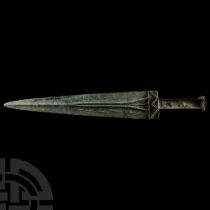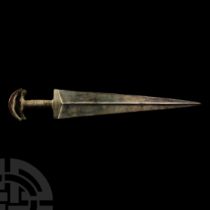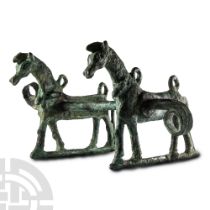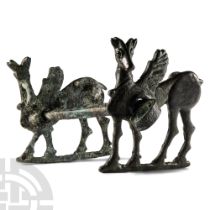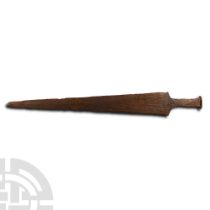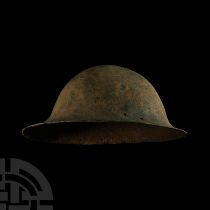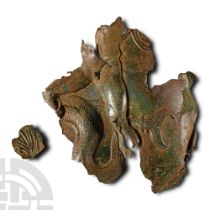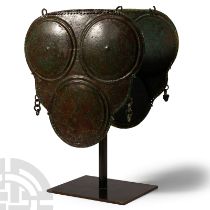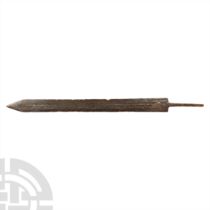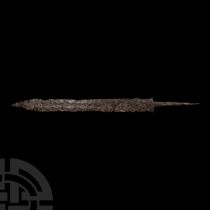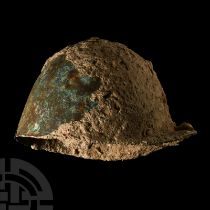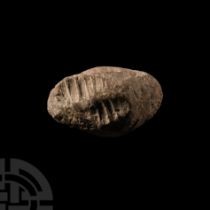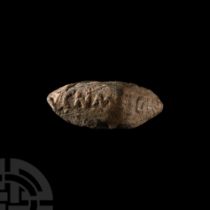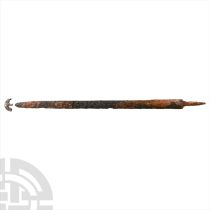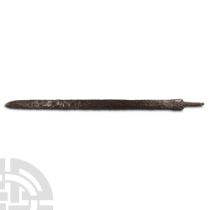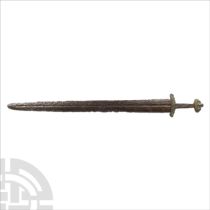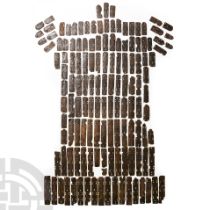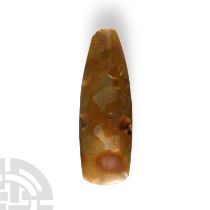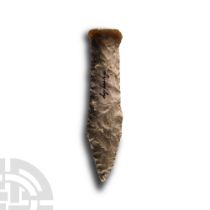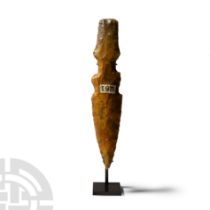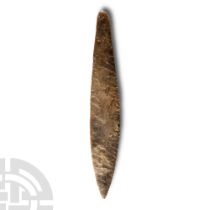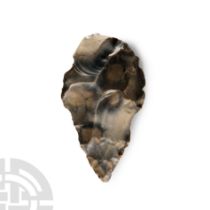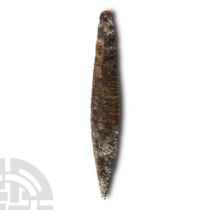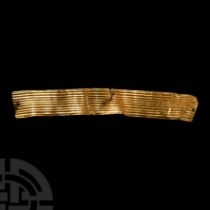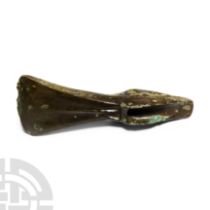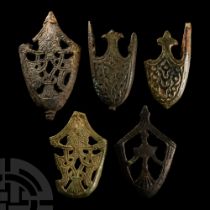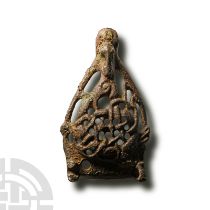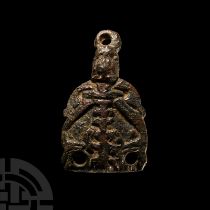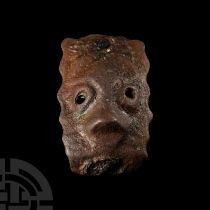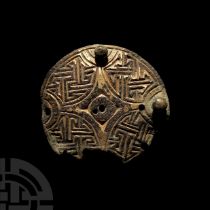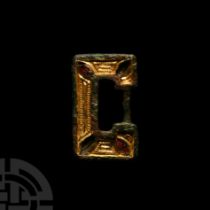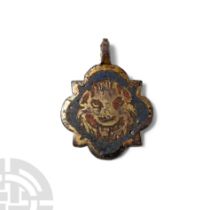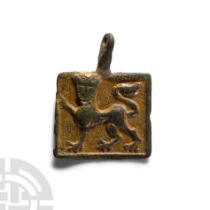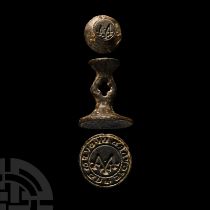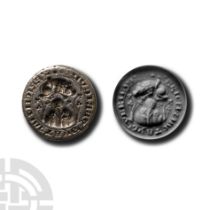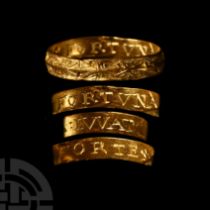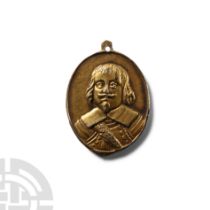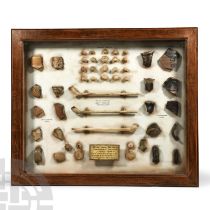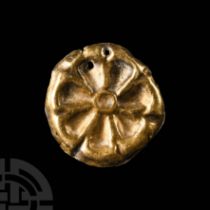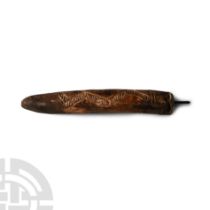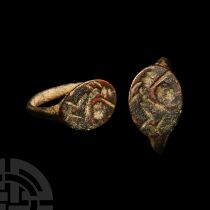Refine your search
Estimate
Category
Remove filter- Arms, Armour & Militaria (216)
Creator / Brand
Item Type
- Armour (39)
- Sword (35)
- Dagger (26)
- Round (22)
- Spear (18)
- Shield (16)
- Axe (13)
- Spearhead (13)
- Belt (12)
- Axehead (11)
- Javelin (11)
- Scabbard (11)
- Helmet (10)
- Knife (10)
- Pin (10)
- Knives (9)
- Bomb (8)
- Grenade (8)
- Dirk (7)
- Musket (7)
- Cap (6)
- Brooch (5)
- Bow (4)
- Crossbow (4)
- Sabre (4)
- Slingshot (4)
- Spatha (4)
- Tunic (4)
- Button (3)
- Cannon (3)
- Cuirass (3)
- sword belt (3)
- Ammunition (2)
- Badge (2)
- Badges (2)
- Belt buckle (2)
- Blunt (2)
- Book (2)
- Club (2)
- Fighting Knives (2)
- Insignia (2)
- Lance (2)
- Mace (2)
- Militaria (2)
- Military Belt (2)
- Antique Arms (1)
- Battle Axe (1)
- Bayonet (1)
- Bec De Corbin (1)
- Cannonball (1)
- Cleaver (1)
- Gauntlet (1)
- Halberd (1)
- Lamellar Armour (1)
- Lucerne Hammer (1)
- Medal (1)
- Medallion (1)
- Military Helmet (1)
- Military Insignia (1)
- Pistol (1)
- Polearm (1)
- Revolver (1)
- Rifle (1)
- Sheath (1)
- Uniform (1)
- Xiphos (1)
Filtered by:
- Category
- List
- Grid
A subscription to the Price Guide is required to view results for auctions ten days or older. Click here for more information
Late Period, 664-332 B.C. Carved from cream-coloured Egyptian alabaster containing fine veining throughout; relatively thick walls flaring to form...
Circa 5th-4th century B.C. Modelled as a skinned lion's head with fierce facial detailing; made for soldering to an articulated round handle. Cf. ...
Circa 5th-4th century B.C. Formed as the skinned head and forepaws of a lion, together with two lateral handles with fastening holes surmounted by...
Greek Bronze Situla
5th-4th century B.C. Tall vessel with dished underside, elegant carination at the shoulder, rolled rim; lateral vertical seams each covered by an ...
4th century B.C. The vessel with integral round-section upward-facing handles, a third, round-section handle placed vertically between shoulder an...
6th-4th century B.C. Sheet-silver figure with horizontal banding to the cloak and tunic, quiver to the left shoulder; old collector's label '8' to...
4th-5th century A.D. Of fine deep red clay, thin smooth slip on top, a large lioness leaping to right towards a bestiarius (animal fighter) armed ...
Roman Bronze Gladiator Mount
Circa 1st-2nd century A.D. Modelled in the half-round with hollow reverse and fixing stud; gladiator advancing with a gladius short-sword drawn in...
2nd-3rd century A.D. Modelled naturalistically in the round, directing his gaze upwards left, the eyes with sculpted pupils originally decorated w...
2nd-3rd century A.D. Decorated with stamped patterns comprising dolphins, vegetal and floral patterns, motifs with ivy leaves and floral border st...
2nd-3rd century A.D. The upper part of a Beneficiarius dedicatory spear or sceptre, comprising a circular-section shaft with an ivy leaf finial, a...
3rd-4th century A.D. With spurs to the shoulders, domed bezel with central roundel, enamel fill. 2.97 grams, 21.66 mm overall, 16.06 x 17.11 mm i...
1st century B.C.-1st century A.D. With high-relief image depicting a she-wolf in profile advancing beneath a tree, with an infant or boy (Romulus?...
Byzantine Gold Ring with Cross
Circa 6th-8th century A.D. Composed of a slender rectangular-section hoop and cruciform bezel with expanding round-section arms, central dome and ...
Babylonian Cuneiform Tablet, a Letter From a Local Governor in Arrapha to His Colleague in Ešnunna
Late 18th century B.C. Written across two principal faces and three side edges, reading:1-2) Say to Zakur-ahum, thus says Uzazza, your brother.3) ...
Circa 2nd millennium B.C. With detailed frieze including a standing figure with tall helmet, raising his arm to strike a similar figure with both ...
2nd-1st millennium B.C. Polished haematite cylinder with incuse frieze depicting a standing profile human figure in flounced kilt and mesh tunic b...
Circa 8th century B.C. The blade with mid-rib divided in five vertical lines, emerging from the mouth of two stylised lion-heads, the eyes recesse...
Late 2nd millennium B.C. With solid cast hilt, straight horizontal guard with turquoise inlay; plain narrow grip with conical hollow cast mushroom...
Luristan Bronze Short Sword
10th century B.C. With triangular blade in outline and prominent mid-rib divided in three sections; square shoulders with rectangular guard; recta...
North Western Bronze Short Sword
2nd-1st millennium B.C. Of fine quality, showing an open cast crescentic pommel with raised midrib and two parallel shallow lines across the top; ...
11th-8th century B.C. The cheekpieces formed as stylised horses with small ears, elongated heads and long tails, a circular opening to the body fo...
Luristan Bronze Horse Bit
9th-8th century B.C. The cheekpieces formed as winged deer with horns and small ears, a circular opening to the body for the bar to pass through, ...
4th century B.C. Of Central Asian typology, strong hilt and narrow ogival guard with Steppe style ornamentation, tipped hilt, triangular tapering ...
Villanovan Bronze Helmet
8th century B.C. With rounded bowl and flared rim; three sets of paired piercings for attachment of leather cheek-flaps; cracked; accompanied by a...
Circa 4th-3rd century B.C. Comprising an embossed fragment of a breast-plate from muscle-type armour (thorax statos) representing Herakles fightin...
South-Central Italy, 420-350 B.C. Matched pair of Samnite triangular breast and backplates, a suite of 'triple-disc' type, each with three repouss...
Late 2nd-early 3rd century A.D. With double-edged blade of Lauriacum Hromówka typology with blood channels running for the most of its length; inl...
Roman Iron Gladius
1st-2nd century A.D. Or semi-spatha blade with parallel-sided lentoid-section body and a long rectangular-section tang; Mainz type, Wederath-Cante...
1st century B.C. Montefortino helmet with bulbous domed skull and a plain crest knob with flattened top; plain and flat neck guard with thickened ...
1st century A.D. Lentoid section with a raised 'keel' to one end, depicting a stylised scorpion. Cf. Schinco, G., Small, A.M., 'A previously unkno...
1st century B.C. Biconical lead slingshot (glans) with inscription in Latin letters 'CN' (Cneius) 'MAG' (Magnus) on one side, and 'IMP' for 'IMPER...
4th century A.D. With a double-edged blade of Illerup-Wyhl Type, narrow parallel cutting edges tapering towards the point; remains of wooden scabb...
5th-6th century A.D. The double-edged spatha with parallel-sided blade and pointed tip, battle nicks to both cutting edges; the hilt and tang exte...
11th-13th century A.D. Couronian sword of Petersen Type K with double-edged tapering blade and tapering fullers; bronze cross-guard extending at e...
Circa 12th-13th century A.D. A Byzantine or Eastern European armour group comprising 138 plates from a klivanion in forty different shapes; origin...
Neolithic Period, circa 6th-4th millennium B.C. Beautifully shaped and polished axe with gently curved cutting edge, tapering butt. 678 grams, 20...
Neolithic Period, circa 1950-1600 B.C. Stout knapped dagger with tick lenticular-section body, integral T-shaped pommel; old inked label: 'Lyngby'...
Circa 3rd millennium B.C. Finely knapped lentoid-section dagger with lateral recesses and square butt; old collector's label '281'. Cf. similar in...
Neolithic Period, circa 2400-2050 B.C. Lanceolate with narrow rounded butt; tip professionally restored. 131 grams, 26.2 cm (10 3/8 in.).Acquired...
Lower Palaeolithic Period, circa 400,000-200,000 B.P. Long blade with small portion of cortex at the upper end, sharply tapering point with edges ...
Neolithic Period, circa 2250-2050 B.C. Narrow dagger with acute pointed tip, thickened rear, old inked accession number '491'. 66 grams, 19.3 cm ...
Circa 2350-800 B.C. Rectangular sheet-gold ribbon, plaque or cordon with reeded outer face and plain reverse, mounting hole to each end. Cf. simil...
Bronze Age Palstave Axehead
Middle Bronze Age, 1400-1150 B.C. Triangular flange on each side rising from the butt to the stop bar; below the septum, a hollow to each face; na...
10th-11th century A.D. Comprising: two examples of a long and narrow tongue-shaped type (Paulsen's Gruppe V 2A, Untergruppe C) with scooped upper ...
11th century A.D. The substantial heater-shaped plaque with spectacular openwork Urnes style design, the standing beast with entwined tendrils, pr...
11th century A.D. A well defined Williams's Class A Type 6 mount comprising a D-shaped plaque with high-relief central tree or skeleton, a serpent...
Circa 11th century A.D. With stylised face and pierced eyes, Williams's Class B Type 4 with vestigial lower ledge. Cf. Williams, D., Late Saxon St...
8th-early 9th century A.D. Plate brooch with raised rim and four applied knops (two absent); central disc surrounding by four radiating arms exten...
Late 5th-early 7th century A.D. Marzinzik's Type I.6 rectangular loop with thick edges, recessed bar, leaf-shaped garnet to each angle, punched de...
Circa 14th-15th century A.D. Quatrefoil pendant with interstitial spurs; reserved lion mask on an enamelled field, with tongue protruding. 12.6 g...
Medieval Knight's Gilt Bronze Enamelled Heraldic Horse Harness Pendant with Crowned Royal Lion
Circa 14th century A.D. Rectangular pendant with pelletted border, reserved repoussé crowned lion passant gardant on a keyed field to accept ename...
Circa 1250-1450 A.D. Circular die with central W motif and S’ CVNRADI GVFMAN for 'Seal of Conrad Gufman' legend, a tapering ovate sectioned handle...
Circa 14th-15th century A.D. Discoid plaque with strap and loop to the reverse; central motif of flowers and a sleeping lion within a pelletted bo...
1500-1650 A.D. Broadly rectangular in cross-section and constructed from two sheets of gold; the external hoop carrying an etched decorative desig...
1642 A.D. Cast and chased badge of Robert Devereux, Earl of Essex, by Thomas Simon (or Thomas Rawlins?), bifacial with obverse portrait bust of th...
Circa 1645-1646 A.D. In a glazed wooden case with various artefacts including musket balls, ceramic fragments, and three complete clay pipes by Ro...
Egyptian Gold Rosette Mount
Late Period, 664-323 B.C. Made of a round gold sheet composing distinctive seven-petalled flower. Cf. Kantor, H.J., Plant Ornament in the Ancient ...
Cypriot Terracotta Votive Horn
2100-1850 B.C. Tapering round-section votive with reserved zigzag bands of dense linear hatching; modern mounting pin. 71 grams, 13.5 cm (5 3/8 i...
Circa 2nd-1st century B.C. With a round-section hoop and oval-shaped bezel, intaglio image of an advancing warrior holding a shield and a sword. ...

